
Mangrove jack are one of the most popular sportfish in Australia. They are hard fighters and put up a great battle, making them a favourite amongst anglers. Catching mangrove jack can be challenging, but with the right techniques it is possible to land these fish almost every time.
What are Mangrove Jack?
Mangrove jack are a predatory fish found in estuaries and coastal waters throughout Northern Australia. They are a member of the LUTJANIDAE family of tropical snappers and are commonly called Mangrove jacks or Reef jacks, depending on where they are caught. According to the DAF, estuary-caught male fish mature at around 4-5 years old (45-50 cm long), with females maturing between 5-8 years old (50-55 cm). Maximum age may exceed 31 years.
In southern Queensland, mangrove jacks stay in the estuary for most of their life cycle with spawning occurring on inshore reefs. They grow well over 50cm to 65cm. In northern areas, they often migrate to inshore and offshore reefs at around 40-45cm in length and stay there, where they are often called reef jacks. Reef jacks have been known to grow over 125cm, weigh over 17kg, and live for up to 39 years, often found near other reef species like Coral Trout, Nannies, and Red Emperors, especially at night.
Anglers can find mangrove jack along the northern coastline of Australia and even in freshwater sections of estuaries and rivers, with reports of catches as far south as the Hawkesbury River near Sydney, the Illawarra region, and Shark Bay in Western Australia. Mangrove Jacks are classified as a Demersal species with the scientific name Lutjanus argentimaculatus.

How to Identify a Mangrove Jack
Mangrove jack are typically bright red but can vary in tones of brown, pink, or silver-grey depending on their habitat, earning the nickname “Red dogs.” They have a shallower caudal pit compared to Red Bass, which helps with identification. Mangrove jacks are known for their aggressive feeding behavior and will attack bait and lures forcefully. Due to their strength, using heavier line and leader is recommended—typically, 30lb braid with a 50lb mono leader is sufficient.
Best Conditions to Catch Mangrove Jack
Mangrove Jack can be caught throughout the year in sub-tropical and tropical Australia, but the best time is from October to March, particularly on humid days or nights with high barometric pressure and warm water temps. They are active during daylight hours in shaded areas and at night, where larger versions aggressively hit live baits.
Size and Possession Limits:
- Queensland: 35cm size limit, possession limit of 5.
- New South Wales: No size limit, possession limit of 5.

What is the Diet of a Mangrove Jack?
Mangrove jacks are predatory and feed on baitfish, prawns, crabs, and other crustaceans. The best bait depends on the location and conditions. Mangrove jack also respond well to artificial lures, including soft plastics, spinnerbaits, and crankbaits. Matching the bait or lure to local prey ("matching the hatch") increases the chances of success.
Best Gear for Mangrove Jack
Fishing gear varies based on location and conditions. Some anglers prefer a soft-tip rod with a strong mid-section, while others opt for a stiffer rod with a line weight of 10-15kg. Abrasion-resistant leaders and strong knot connections are essential for handling these powerful fish.
Best Live Bait for Mangrove Jack
Some of the best live baits include prawns, crabs, and poddy mullet. These baits should be selected based on the fishing environment and local prey availability.

Recommended Lures for Mangrove Jack
Mangrove jack are effectively caught with a variety of lures. Deep-diving lures work best to reach larger fish in deeper water. Aggressive wobbling lures in the 40-60mm range create more vibration, helping attract mangrove jack from a distance.

Best Retrieval Techniques for Mangrove Jack
When fishing for mangrove jack, use a mix of fast and slow retrieve techniques. Soft plastics, spinnerbaits, and crankbaits work well with a fast retrieve to maximize vibration and attract mangrove jack.
How to Know When Mangrove Jack is Biting and Setting the Hook
Mangrove Jack are strong fighters, so you’ll feel a distinct tug when they bite. To secure the hook, strike quickly and with force to increase your chances of landing the fish.
Landing Mangrove Jack
Once landed, handle mangrove jack carefully to avoid injury from their sharp teeth. Removing the hook with caution is advised.

Are Mangrove Jacks Good Eating?
Mangrove jack are considered excellent eating fish, enjoyed fresh or frozen, and are popular among anglers for their tasty flesh.
Putting it All Together
Watch the video below for more tips on catching Mangrove Jack:
Article by Derek Maynard





